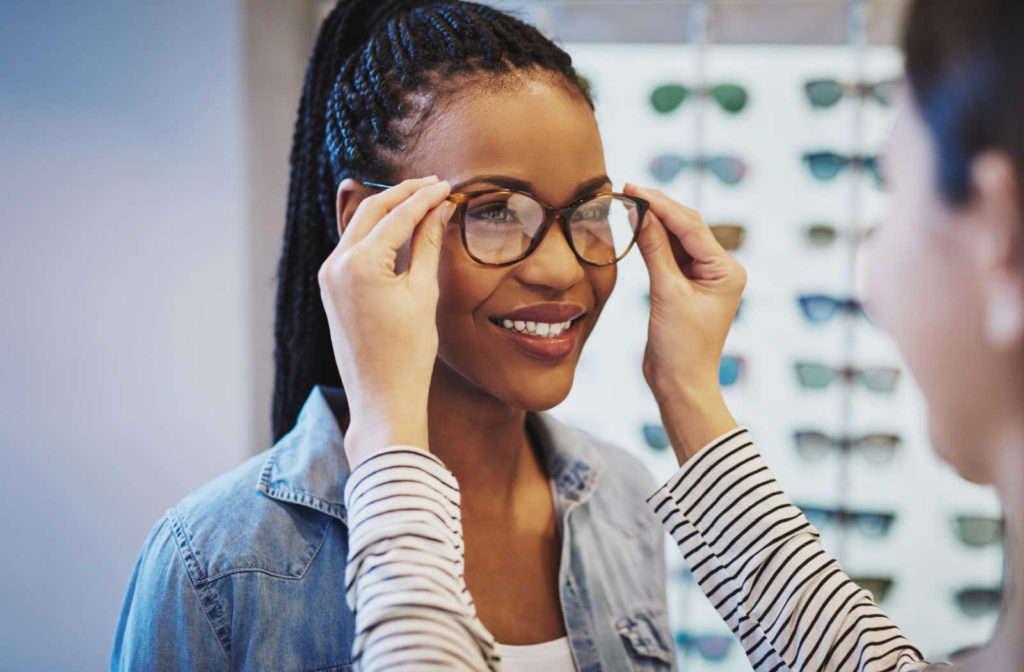Looking & Seeing Your Best with Glasses
When your optometrist tests your eyesight for a glasses prescription, it’s only the first step in your glasses journey. The fit of your spectacles is just as crucial to looking and seeing your best as your choice of frames or lenses.
The fit of your glasses can also change over time. Getting older frames and lenses assessed or refitted as necessary can benefit your vision and eye health.
Why Does Fit Matter?
It’s likely not surprising to hear that ensuring your glasses fit correctly is important. But how crucial is proper fit? And how do you know if your glasses fit?
When your glasses slide down your nose, or the lenses are positioned at different levels, it’s easy to see a problem. Yet, fit issues can also be much more subtle, impacting the effectiveness and comfort of your prescription eyewear.
Pupil Alignment
Pupil alignment and pupillary distance are necessary to orient your lenses’ position. Your pupils should be positioned at the optical center of each lens for your prescription to work effectively.
Imagine you’re looking through a magnifying glass. Holding the magnifying glass up to the side of your eye makes it more challenging to see clearly than holding the glass in a central position. The placement and measurements of the frame, bridge, arm, and lens impact where your pupils naturally rest when looking through your glasses.
When properly fitted, your pupil should align about one-third down from the top of the lens. The distance between the lens’s edge and the eye’s corner should be equal on both sides.
Frame Width
Your frame’s width (horizontal measurement) should be slightly wider than your face. While your frames should fit securely, the edges shouldn’t press into your skin. There should be less than a finger’s width between your temple skin and frame.
Arm Length
The arm length (also called the temple) should be long enough to wrap behind your ear. You should be able to shake your head and nod comfortably without the arms slipping off. The arms should touch your head right before your ears.
If you’re experiencing discomfort or pressure in the temple area, you may need wider frames or an arm adjustment.

Bridge Placement
The bridge (the middle piece that rests on your nose) should fit comfortably but securely. You may have frames with nose pads that prevent slipping. The weight of your glasses should feel balanced, and the piece shouldn’t feel tight or leave marks on your nose.
There are also frames designed for unique nose shapes, such as a flatter bridge. If the nose piece is uncomfortable or your glasses move around, you may need a better bridge fit.
Lens Size
Your lens size should complement the width of your frame, pupil distance, and field of vision. The lens size can also affect the function of your prescription. For example, if you have bifocals or progressive lenses, you need enough room to accommodate multiple prescriptions.
Face Shape
Your frames should rest comfortably around the middle height of your face, no higher than your eyebrows and about as wide as your temples.
Choosing frames that flatter your face shape can help you feel confident wearing your spectacles. Cool or warm-tone frames can compliment your skin tone or eye color. Contrasting your frame shape with your face shape can also help flatter your facial features.
An optician can provide personalized recommendations based on your unique features, but here are some general ideas to get started with:
- Diamond faces (narrow top & bottom with broad cheekbones) may be complemented with frames with distinctive or thick brow or upper frame designs. Consider trying a pair of horn-rimmed or cat-eye glasses.
- Heart faces (broad forehead & narrow chin) often suit oval-shaped or thin frames best. Aviators and bottom-heavy frames can create a balanced look. You might also try round frames to pull focus away from the forehead and toward your eyes.
- Oval faces (rounded forehead & chin, sometimes egg-shaped) have balanced facial proportions and suit many styles. You may want to try oversized, geometric, or square designs for a unique or bold look.
- Round faces (equal width & length) suit angular or rectangular frames that can lengthen the face and flatter features.
- Square faces (broad forehead & equal sides) work well with narrow frames to make the face shape appear longer. Browline, oval, or round frames can help soften facial features.
- Triangle faces (wider bottom & narrow top) work well with frames with heavier tops, such as cat-eye glasses. D-frames or aviators can also create a balanced appearance.
Professionally Fitted Frames & Lenses
Your glasses are a part of your lifestyle, and you deserve to love your frames. Whether you want your glasses to blend in or stand out, properly fitted frames are essential for comfortable vision correction. At Arena Eyeworks, our top priority is ensuring your eyes are healthy and your eyewear works for your needs. We’d love to discuss your glasses comfort and help you find the best fit possible. Book an appointment today!



